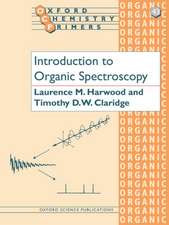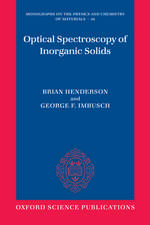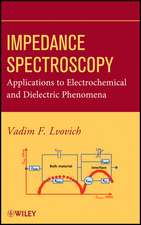Ultraviolet Spectroscopy of Proteins
Autor Alexander P. Demchenkoen Limba Engleză Paperback – 17 noi 2011
Preț: 644.18 lei
Preț vechi: 757.85 lei
-15% Nou
Puncte Express: 966
Preț estimativ în valută:
123.26€ • 129.04$ • 101.99£
123.26€ • 129.04$ • 101.99£
Carte tipărită la comandă
Livrare economică 07-21 aprilie
Preluare comenzi: 021 569.72.76
Specificații
ISBN-13: 9783642708497
ISBN-10: 3642708498
Pagini: 328
Ilustrații: XI, 312 p.
Dimensiuni: 170 x 244 x 25 mm
Greutate: 0.52 kg
Ediția:Softcover reprint of the original 1st ed. 1986
Editura: Springer Berlin, Heidelberg
Colecția Springer
Locul publicării:Berlin, Heidelberg, Germany
ISBN-10: 3642708498
Pagini: 328
Ilustrații: XI, 312 p.
Dimensiuni: 170 x 244 x 25 mm
Greutate: 0.52 kg
Ediția:Softcover reprint of the original 1st ed. 1986
Editura: Springer Berlin, Heidelberg
Colecția Springer
Locul publicării:Berlin, Heidelberg, Germany
Public țintă
ResearchCuprins
1. Spectroscopic Properties of Protein Chromophores.- 1.1 Basic Principles and Definitions of Light Absorption and Emission Spectroscopy.- 1.1.1 Absorption.- 1.1.2 Emission.- 1.2 Light Absorption by the Amide Chromophore..- 1.3 The Absorption Spectra of Amino Acid Residues and Their Analogs.- 1.3.1 Phenylalanine..- 1.3.2 Tyrosine.- 1.3.3 Tryptophan.- 1.3.4 Other Protein Chromophores.- 1.4 Emission Properties of Aromatic Amino Acids.- 1.4.1 Phenylalanine.- 1.4.2 Tyrosine.- 1.4.3 Tryptophan.- 1.5 Conclusions.- 2. Display of Intramolecular and Intermolecular Interactions in Electronic Spectra of Amino Acids and Proteins.- 2.1 Spectroscopic Analysis of the Environmental Polarity and Polarizability Effects.- 2.2 Spectroscopic Manifestation of the Hydrogen Bond.- 2.3 Substitution and Charge Effects.- 2.4 Charge-Transfer Complexes.- 2.5 Broadening of Electronic Spectra.- 2.6 Excited State Processes.- 2.6.1 Solvent Relaxation.- 2.6.2 Exciplexes.- 2.6.3 Excited State Proton Transfer.- 2.6.4 Excited State Electron Transfer.- 2.6.5 On the Nature of the Emitting State of Indole and Tryptophan.- 2.7 Conclusions.- 3. Difference Spectra of Proteins •.- 3.1 Informational Significance of Difference Spectra.- 3.2 Studies of Protein Denaturation.- 3.3 Functional Transformations and Association of Proteins.- 3.3.1 Conformational Changes Under Activation of Precursor Proteins.- 3.3.2 Formation of Enzyme-Substrate and Enzyme-Inhibitor Complexes. Studies on Mechanisms of Catalytic Activity.- 3.3.3 Interaction of Proteins with Small Molecules and Ions.- 3.3.4 Association of Subunits and Formation of Supermolecular Structures.- 3.4 Solvent Perturbation Difference Spectra and Studies in Surface Topography.- of Protein Molecules.- 3.5 Protein-Model Difference Spectra.- 3.6 Conclusions.- 4.Thermal Perturbation Difference Spectroscopy and Temperature-Dependent Conformational Transitions of Proteins.- 4.1 Characteristics of Tyrosine, Tryptophan, and Phenylalanine Spectra and Their Origin.- 4.1.1 Quantitative Analysis of the Experimental Data. Account of Correction Factors.- 4.1.2 TPDS of Tryptophan, Tyrosine, and Phenylalanine.- 4.1.3 Origin of Thermal Perturbation Difference Spectra.- 4.1.4 On the Nature of Longwave Shift with the Temperature Rise.- 4.2 Studies of Thermal Perturbation of Tyrosine, Tryptophan, and Phenylalanine Residues in Proteins.- 4.2.1 Drop in Intensity of TPDS.- 4.2.2 Longwave Shift of TPDS Maxima.- 4.2.3 Absence of Tyrosine Maxima at 287-289 nm.- 4.2.4 Presence of TPDS Maxima in the Region of 300-307 nm.- 4.3 TPDS and Protein Conformational Transitions Depending on Temperature.- and pH of the Medium.- 4.4 Conclusions.- 5. Derivative Spectroscopy of Aromatic Amino Acids and Proteins.- 5.1 The Theoretical Grounds.- 5.2 Derivative Spectra of Tryptophan, Tyrosine, and Phenylalanine.- 5.3 Influence of Solvents on the Derivative Spectra of Aromatic Amino Acids.- 5.4 Analysis of Chromophore Environment in Proteins.- 5.4.1 The State of Phenvlalanine Residues.- 5.4.2 The State of Tyrosine and Tryptophan.- 5.5 Studies of Conformational Transitions in Proteins. Difference-Derivative Spectroscopy.- 5.6 Studies on Broadening of Absorption Spectra.- 5.7 Conclusions.- 6. Spectrophotometric Titration of Proteins.- 6.1 The Spectrophotometric Titration Method.- 6.2 Titration of Tyrosine Residues at Alkaline pH.- 6.3 Conclusions.- 7. Fluorescence Molecular Relaxation Spectroscopy.- 7.1 Relaxational Shift of the Fluorescence Spectra.- 7.2 Time-Resolved Spectroscopy.- 7.3 Edge Excitation Fluorescence Spectroscopy.- 7.3.1 Physical Principles.- 7.3.2 The Effect of Selective Excitation on Fluorescence Spectra of Indole and Tryptophan.- 7.3.3 The Structural Relaxation of Indolic Chromophore in Proteins.- 7.4 Conclusions.- 8. Fluorescence Quenching.- 8.1 Effects of External Difiusional Quenchers.- 8.2 Quenching by Protein Internal Groups and Its Temperature Dependence.- 8.3 Conclusions.- 9. Nonradiative Transfer of Electronic Excitation Energy.- 9.1 General Theory.- 9.2 The Effect of Inhomogeneous Broadening of Spectra and Molecular Relaxation.- on the Nonradiative Transfer of Energy.- 9.3 The Energy Transfer Between Aromatic Amino Acid Residues in Proteins.- 9.4 Conclusions.- 10. Fluorescence Polarization and Rotational Mobility.- 10.1 The Method of Fluorescence Depolarization.- 10.2 The Effect of Dipolar-Reorientational Relaxation on Rotational Depolarization of Fluorescence.- 10.3 Intramolecular Mobility in Proteins as Estimated by Data on Fluorescence Polarization 204 10.4 Conclusions.- 11. Intrinsic Phosphorescence of Proteins.- 11.1 General Mechanisms of Phosphorescence.- 11.1.1 The Principle of the Method,.- 11.1.2 Inhomogeneous Broadening and Molecular Relaxations in Spectroscopy of the Triplet State.- 11.1.3 Indole and Tryptophan Phosphorescence.- 11.2 Phosphorescence Assay of Protein Structures.- 11.2.1 Low-Temperature Phosphorescence.- 11.2.2 Temperature Dependence of Phosphorescence Parameters.- 11.2.3 Phosphorescence of Proteins and Membranes at Room Temperature.- 11.2.4 Phosphorescence and Optically Detected Magnetic Resonance.- 11.3 Conclusions.- 12. Employment of Ultraviolet Spectroscopy in Analytical Chemistry of Proteins.- 12.1 A Method for the Quantitative Spectroscopic Determination of Protein Concentration.- 12.1.1 Determination of Protein Concentration in the 280 nm Region.- 12.1.2 Determination of Protein Concentration in the Far-Ultraviolet Region.- 12.1.3 Determination of Protein Concentration in the Presence of Other Light-Absorbing Substances.- 12.2 Determination of Tryptophan, Tyrosine, and Phenylalanine Content in Proteins.- 12.2.1 Determination of Tyrosine and Tryptophan Concentration by Absorption Spectra..- 12.2.2 Determination of Tyrosine, Tryptophan, and Phenylalanine by Use of Derivatives of the Absorption Spectrum.- 12.2.3 Employment of the Method of Difference and Thermal Perturbation Difference Spectra.- 12.2.4 Fluorescence Spectroscopic Tryptophan and Tyrosine Assay.- 12.3 Spectroscopic Studies of Peptide Bond Splitting in Protein Hydrolysis.- 12.4 Study of the Modification and Oxidation of Chromophore Groups.- 12.5 Hydrogen-Deuterium Exchange in Peptides and Proteins.- 12.6 Conclusions.- 13. Experimental Technique in Protein Spectroscopy.- 13.1 Spectrophotometric Analysis.- 13.1.1 Spectrophotometers, Their Main Characteristics and Calibration.- 13.1.2 Peculiarities of Recording the Difference Spectra of Proteins.- 13.1.3 Difference Spectra of Protein Preparations Differing in Initial Concentration.- 13.1.4 The Recording of Derivative Spectra.- 13.1.5 Turbidity of Protein Preparation and Possibilities of Its Account.- 13.2 Technique of Luminescence Studies.- 13.2.1 Steady State Spectra of Excitation and Fluorescence.- 13.2.2 Technique of Polarization Measurements.- 13.2.3 Technique of Time-Resolved Fluorimetry.- 13.2.4 Technique of Phosphorescence Studies.- 13.3 Multiparametric Detection and Analysis of Spectroscopic Data.- 13.4 Conclusions.- 14. General Conclusions and Prospects.- 14.1 Advantages and Limitations of Molecular Probe Methods.- 14.2 The Comparative Analysis of UV-Spectroscopic Information and the Data.- of X-Ray Diffraction Analysis andNMR.- 14.3 The Spectroscopic Manifestation of the Dynamic Nature of Proteins.- 14.3.1 Distribution of Microstates.- 14.3.2 Analysis of the Dynamics by Emission Spectrscopy.- 14.3.3 Conformational Dynamics and Functional Properties of Proteins.- 14.4 Subject and Method in Protein Spectroscopy.- References.











